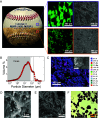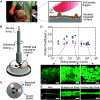Soft matter mechanics of baseball's Rubbing Mud
- PMID: 39495943
- PMCID: PMC11588067
- DOI: 10.1073/pnas.2413514121
Soft matter mechanics of baseball's Rubbing Mud
Abstract
Researchers looking for sustainable materials with optimal mechanical properties may draw inspiration from a baseball tradition. For nearly 100 y, a mysterious mud harvested from an undisclosed river site in New Jersey (USA) has been the agent of choice in the USA's Major League Baseball for "de-glossing" new baseballs. It is unclear, however, what makes this "Rubbing Mud" work. Here, we perform a multiscale investigation of the rheology and tribology of this mud material under baseball-relevant conditions and identify three mechanisms by which the mud alters the surface properties of the baseball. First, the mud creates a more uniform baseball surface by filling in pores in the leather; this is possible because of its relatively high cohesion (clays and organics) making the material remarkably shear thinning. Second, the residue of cohesive particles coating the baseball effectively doubles contact adhesion. Third, a sparse population of angular sand grains are bonded to the baseball by clay-sized particles, leaving a studded surface that enhances friction. The proportions of cohesive, frictional, and viscous elements in Rubbing Mud conspire to create a soft material with an unusual mix of properties, that could find other applications in the development of sustainable geomaterials. Our improved understanding of the flow and friction of natural muds may also find use in modeling natural hazards such as mudslides and for locomotion in muddy environments.
Keywords: adhesion; baseball mud; geomaterials; rheology; soft tribology.
Conflict of interest statement
Competing interests statement:The authors declare no competing interest.
Figures




References
-
- Zhong X., Deetman S., Tukker A., Behrens P., Increasing material efficiencies of buildings to address the global sand crisis. Nat. Sustainability 5, 389–392 (2022).
-
- Rahmati M., et al. , Soil is a living archive of the earth system. Nat. Rev. Earth Environ. 4, 421–423 (2023).
-
- Gangotra A., Del Gado E., Lewis J. I., 3D printing has untapped potential for climate mitigation in the cement sector. Commun. Eng. 2, 6 (2023).
-
- Avila F., Puertas E., Gallego R., Characterization of the mechanical and physical properties of stabilized rammed earth: A review. Constr. Build. Mater. 325, 126693 (2022).
-
- Losini A. E., et al. , Extended hygrothermal characterization of unstabilized rammed earth for modern construction. Constr. Build. Mater. 409, 133904 (2023).
Grants and funding
LinkOut - more resources
Full Text Sources

